Financial Reporting Analysis: Godwin PLC and FTSE 100 Companies
VerifiedAdded on 2020/10/05
|13
|3746
|212
Report
AI Summary
This report provides a comprehensive overview of financial reporting, encompassing its concept, objectives, and the regulatory framework, including IAS and IFRS. It identifies key stakeholders and discusses the value of financial reporting in fostering industrial growth. The report includes the preparation of financial statements, such as the income statement, statement of changes in equity, and financial position for Godwin PLC. Furthermore, it delves into the interpretation of financial ratios for FTSE 100 index companies, offering insights into their profitability, liquidity, and efficiency. The report also clarifies the differences between IAS and IFRS and explains the benefits of IFRS, concluding with a discussion on varying degrees of IFRS compliance by world organizations and their impact on nations. The report is enriched with working notes, detailed calculations and interpretations of the financial data, making it a valuable resource for understanding financial reporting principles and practices.
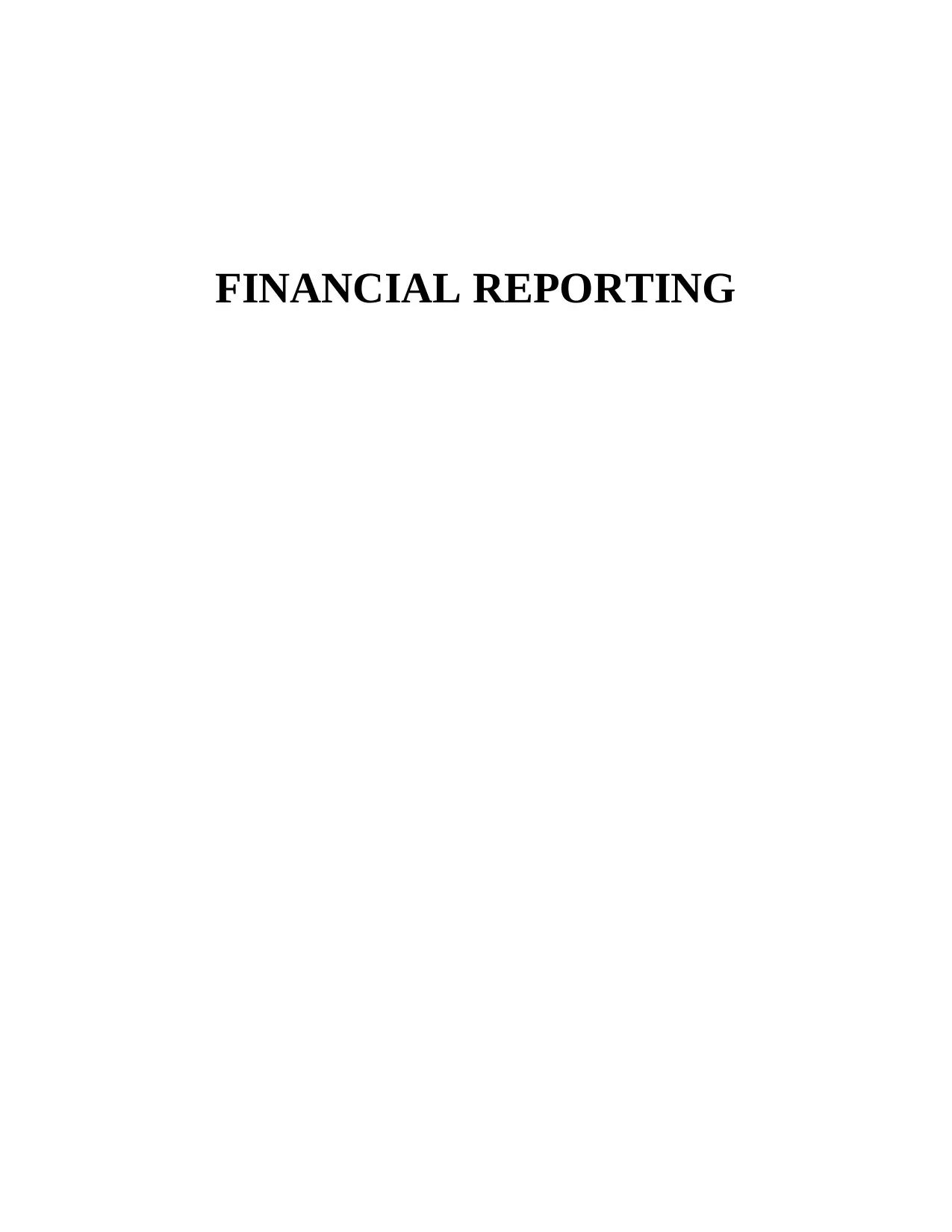
FINANCIAL REPORTING
Paraphrase This Document
Need a fresh take? Get an instant paraphrase of this document with our AI Paraphraser
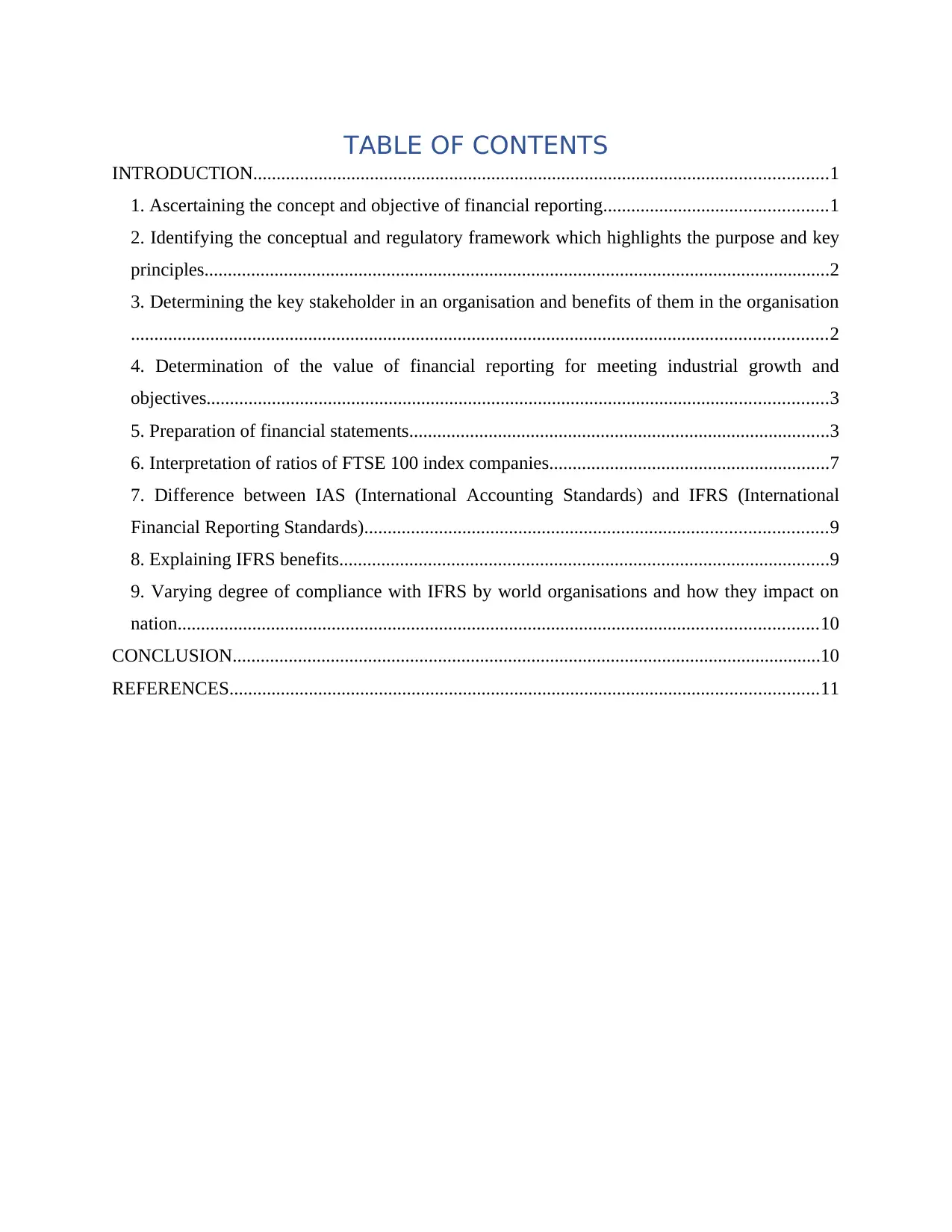
TABLE OF CONTENTS
INTRODUCTION...........................................................................................................................1
1. Ascertaining the concept and objective of financial reporting................................................1
2. Identifying the conceptual and regulatory framework which highlights the purpose and key
principles......................................................................................................................................2
3. Determining the key stakeholder in an organisation and benefits of them in the organisation
.....................................................................................................................................................2
4. Determination of the value of financial reporting for meeting industrial growth and
objectives.....................................................................................................................................3
5. Preparation of financial statements..........................................................................................3
6. Interpretation of ratios of FTSE 100 index companies............................................................7
7. Difference between IAS (International Accounting Standards) and IFRS (International
Financial Reporting Standards)...................................................................................................9
8. Explaining IFRS benefits.........................................................................................................9
9. Varying degree of compliance with IFRS by world organisations and how they impact on
nation.........................................................................................................................................10
CONCLUSION..............................................................................................................................10
REFERENCES..............................................................................................................................11
INTRODUCTION...........................................................................................................................1
1. Ascertaining the concept and objective of financial reporting................................................1
2. Identifying the conceptual and regulatory framework which highlights the purpose and key
principles......................................................................................................................................2
3. Determining the key stakeholder in an organisation and benefits of them in the organisation
.....................................................................................................................................................2
4. Determination of the value of financial reporting for meeting industrial growth and
objectives.....................................................................................................................................3
5. Preparation of financial statements..........................................................................................3
6. Interpretation of ratios of FTSE 100 index companies............................................................7
7. Difference between IAS (International Accounting Standards) and IFRS (International
Financial Reporting Standards)...................................................................................................9
8. Explaining IFRS benefits.........................................................................................................9
9. Varying degree of compliance with IFRS by world organisations and how they impact on
nation.........................................................................................................................................10
CONCLUSION..............................................................................................................................10
REFERENCES..............................................................................................................................11
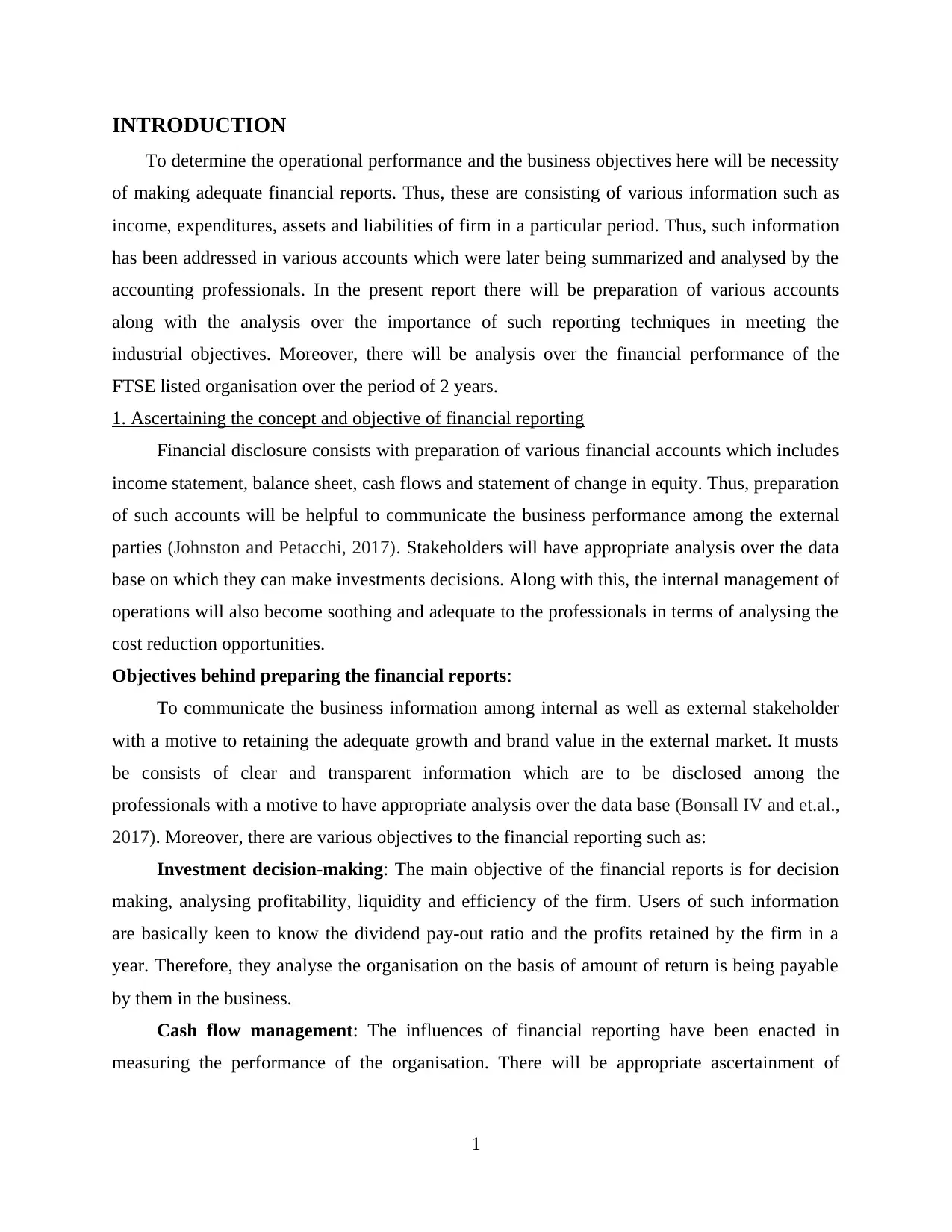
INTRODUCTION
To determine the operational performance and the business objectives here will be necessity
of making adequate financial reports. Thus, these are consisting of various information such as
income, expenditures, assets and liabilities of firm in a particular period. Thus, such information
has been addressed in various accounts which were later being summarized and analysed by the
accounting professionals. In the present report there will be preparation of various accounts
along with the analysis over the importance of such reporting techniques in meeting the
industrial objectives. Moreover, there will be analysis over the financial performance of the
FTSE listed organisation over the period of 2 years.
1. Ascertaining the concept and objective of financial reporting
Financial disclosure consists with preparation of various financial accounts which includes
income statement, balance sheet, cash flows and statement of change in equity. Thus, preparation
of such accounts will be helpful to communicate the business performance among the external
parties (Johnston and Petacchi, 2017). Stakeholders will have appropriate analysis over the data
base on which they can make investments decisions. Along with this, the internal management of
operations will also become soothing and adequate to the professionals in terms of analysing the
cost reduction opportunities.
Objectives behind preparing the financial reports:
To communicate the business information among internal as well as external stakeholder
with a motive to retaining the adequate growth and brand value in the external market. It musts
be consists of clear and transparent information which are to be disclosed among the
professionals with a motive to have appropriate analysis over the data base (Bonsall IV and et.al.,
2017). Moreover, there are various objectives to the financial reporting such as:
Investment decision-making: The main objective of the financial reports is for decision
making, analysing profitability, liquidity and efficiency of the firm. Users of such information
are basically keen to know the dividend pay-out ratio and the profits retained by the firm in a
year. Therefore, they analyse the organisation on the basis of amount of return is being payable
by them in the business.
Cash flow management: The influences of financial reporting have been enacted in
measuring the performance of the organisation. There will be appropriate ascertainment of
1
To determine the operational performance and the business objectives here will be necessity
of making adequate financial reports. Thus, these are consisting of various information such as
income, expenditures, assets and liabilities of firm in a particular period. Thus, such information
has been addressed in various accounts which were later being summarized and analysed by the
accounting professionals. In the present report there will be preparation of various accounts
along with the analysis over the importance of such reporting techniques in meeting the
industrial objectives. Moreover, there will be analysis over the financial performance of the
FTSE listed organisation over the period of 2 years.
1. Ascertaining the concept and objective of financial reporting
Financial disclosure consists with preparation of various financial accounts which includes
income statement, balance sheet, cash flows and statement of change in equity. Thus, preparation
of such accounts will be helpful to communicate the business performance among the external
parties (Johnston and Petacchi, 2017). Stakeholders will have appropriate analysis over the data
base on which they can make investments decisions. Along with this, the internal management of
operations will also become soothing and adequate to the professionals in terms of analysing the
cost reduction opportunities.
Objectives behind preparing the financial reports:
To communicate the business information among internal as well as external stakeholder
with a motive to retaining the adequate growth and brand value in the external market. It musts
be consists of clear and transparent information which are to be disclosed among the
professionals with a motive to have appropriate analysis over the data base (Bonsall IV and et.al.,
2017). Moreover, there are various objectives to the financial reporting such as:
Investment decision-making: The main objective of the financial reports is for decision
making, analysing profitability, liquidity and efficiency of the firm. Users of such information
are basically keen to know the dividend pay-out ratio and the profits retained by the firm in a
year. Therefore, they analyse the organisation on the basis of amount of return is being payable
by them in the business.
Cash flow management: The influences of financial reporting have been enacted in
measuring the performance of the organisation. There will be appropriate ascertainment of
1
⊘ This is a preview!⊘
Do you want full access?
Subscribe today to unlock all pages.

Trusted by 1+ million students worldwide
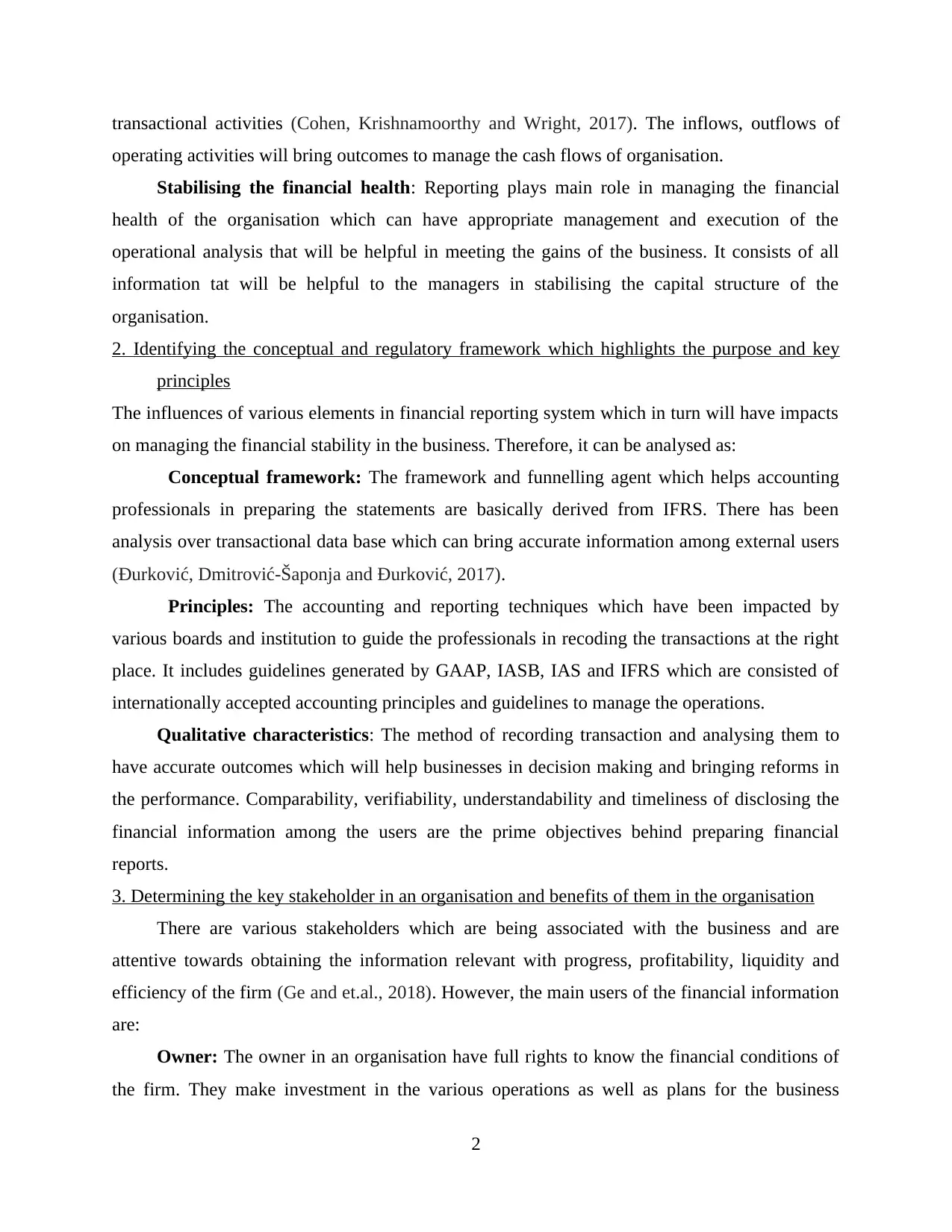
transactional activities (Cohen, Krishnamoorthy and Wright, 2017). The inflows, outflows of
operating activities will bring outcomes to manage the cash flows of organisation.
Stabilising the financial health: Reporting plays main role in managing the financial
health of the organisation which can have appropriate management and execution of the
operational analysis that will be helpful in meeting the gains of the business. It consists of all
information tat will be helpful to the managers in stabilising the capital structure of the
organisation.
2. Identifying the conceptual and regulatory framework which highlights the purpose and key
principles
The influences of various elements in financial reporting system which in turn will have impacts
on managing the financial stability in the business. Therefore, it can be analysed as:
Conceptual framework: The framework and funnelling agent which helps accounting
professionals in preparing the statements are basically derived from IFRS. There has been
analysis over transactional data base which can bring accurate information among external users
(Đurković, Dmitrović-Šaponja and Đurković, 2017).
Principles: The accounting and reporting techniques which have been impacted by
various boards and institution to guide the professionals in recoding the transactions at the right
place. It includes guidelines generated by GAAP, IASB, IAS and IFRS which are consisted of
internationally accepted accounting principles and guidelines to manage the operations.
Qualitative characteristics: The method of recording transaction and analysing them to
have accurate outcomes which will help businesses in decision making and bringing reforms in
the performance. Comparability, verifiability, understandability and timeliness of disclosing the
financial information among the users are the prime objectives behind preparing financial
reports.
3. Determining the key stakeholder in an organisation and benefits of them in the organisation
There are various stakeholders which are being associated with the business and are
attentive towards obtaining the information relevant with progress, profitability, liquidity and
efficiency of the firm (Ge and et.al., 2018). However, the main users of the financial information
are:
Owner: The owner in an organisation have full rights to know the financial conditions of
the firm. They make investment in the various operations as well as plans for the business
2
operating activities will bring outcomes to manage the cash flows of organisation.
Stabilising the financial health: Reporting plays main role in managing the financial
health of the organisation which can have appropriate management and execution of the
operational analysis that will be helpful in meeting the gains of the business. It consists of all
information tat will be helpful to the managers in stabilising the capital structure of the
organisation.
2. Identifying the conceptual and regulatory framework which highlights the purpose and key
principles
The influences of various elements in financial reporting system which in turn will have impacts
on managing the financial stability in the business. Therefore, it can be analysed as:
Conceptual framework: The framework and funnelling agent which helps accounting
professionals in preparing the statements are basically derived from IFRS. There has been
analysis over transactional data base which can bring accurate information among external users
(Đurković, Dmitrović-Šaponja and Đurković, 2017).
Principles: The accounting and reporting techniques which have been impacted by
various boards and institution to guide the professionals in recoding the transactions at the right
place. It includes guidelines generated by GAAP, IASB, IAS and IFRS which are consisted of
internationally accepted accounting principles and guidelines to manage the operations.
Qualitative characteristics: The method of recording transaction and analysing them to
have accurate outcomes which will help businesses in decision making and bringing reforms in
the performance. Comparability, verifiability, understandability and timeliness of disclosing the
financial information among the users are the prime objectives behind preparing financial
reports.
3. Determining the key stakeholder in an organisation and benefits of them in the organisation
There are various stakeholders which are being associated with the business and are
attentive towards obtaining the information relevant with progress, profitability, liquidity and
efficiency of the firm (Ge and et.al., 2018). However, the main users of the financial information
are:
Owner: The owner in an organisation have full rights to know the financial conditions of
the firm. They make investment in the various operations as well as plans for the business
2
Paraphrase This Document
Need a fresh take? Get an instant paraphrase of this document with our AI Paraphraser
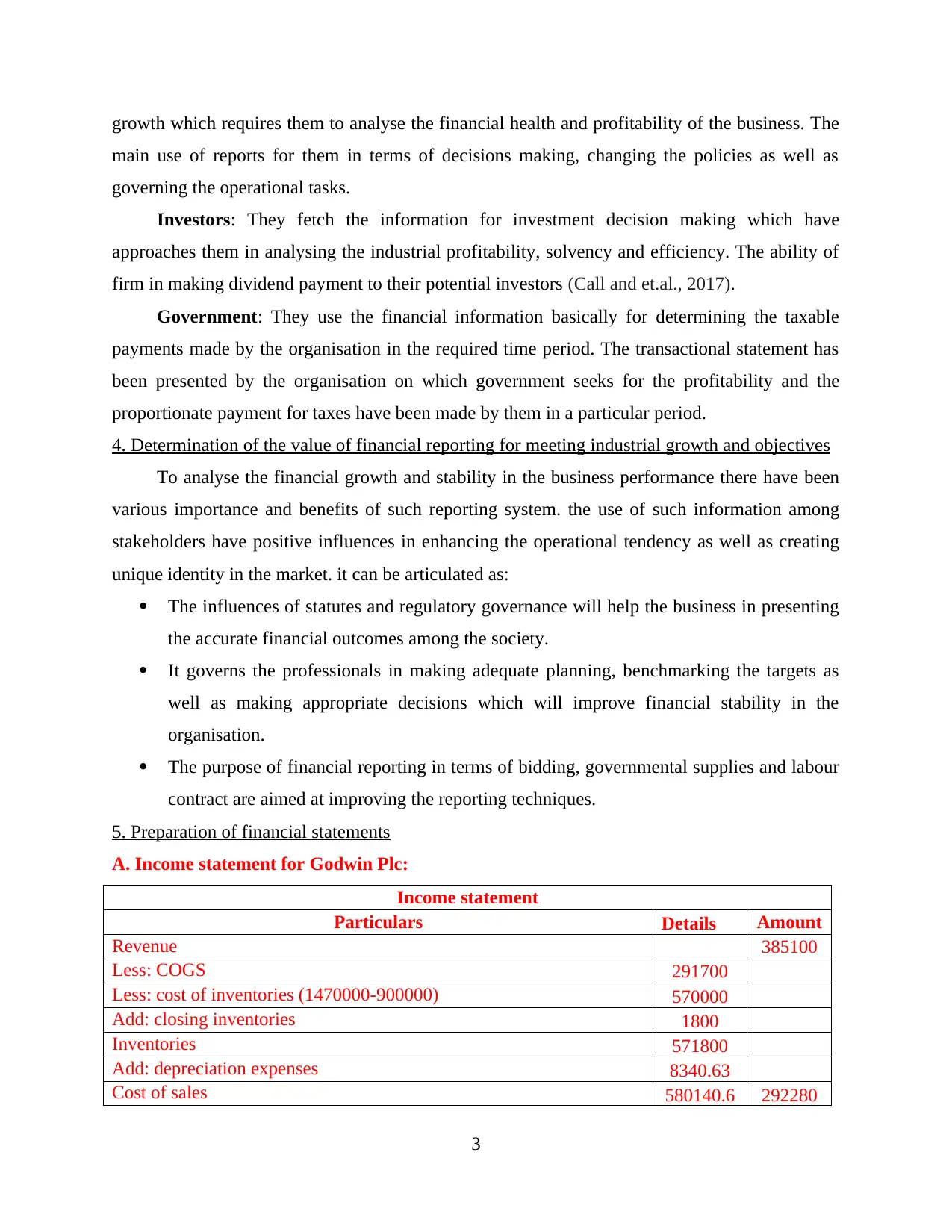
growth which requires them to analyse the financial health and profitability of the business. The
main use of reports for them in terms of decisions making, changing the policies as well as
governing the operational tasks.
Investors: They fetch the information for investment decision making which have
approaches them in analysing the industrial profitability, solvency and efficiency. The ability of
firm in making dividend payment to their potential investors (Call and et.al., 2017).
Government: They use the financial information basically for determining the taxable
payments made by the organisation in the required time period. The transactional statement has
been presented by the organisation on which government seeks for the profitability and the
proportionate payment for taxes have been made by them in a particular period.
4. Determination of the value of financial reporting for meeting industrial growth and objectives
To analyse the financial growth and stability in the business performance there have been
various importance and benefits of such reporting system. the use of such information among
stakeholders have positive influences in enhancing the operational tendency as well as creating
unique identity in the market. it can be articulated as:
The influences of statutes and regulatory governance will help the business in presenting
the accurate financial outcomes among the society.
It governs the professionals in making adequate planning, benchmarking the targets as
well as making appropriate decisions which will improve financial stability in the
organisation.
The purpose of financial reporting in terms of bidding, governmental supplies and labour
contract are aimed at improving the reporting techniques.
5. Preparation of financial statements
A. Income statement for Godwin Plc:
Income statement
Particulars Details Amount
Revenue 385100
Less: COGS 291700
Less: cost of inventories (1470000-900000) 570000
Add: closing inventories 1800
Inventories 571800
Add: depreciation expenses 8340.63
Cost of sales 580140.6 292280
3
main use of reports for them in terms of decisions making, changing the policies as well as
governing the operational tasks.
Investors: They fetch the information for investment decision making which have
approaches them in analysing the industrial profitability, solvency and efficiency. The ability of
firm in making dividend payment to their potential investors (Call and et.al., 2017).
Government: They use the financial information basically for determining the taxable
payments made by the organisation in the required time period. The transactional statement has
been presented by the organisation on which government seeks for the profitability and the
proportionate payment for taxes have been made by them in a particular period.
4. Determination of the value of financial reporting for meeting industrial growth and objectives
To analyse the financial growth and stability in the business performance there have been
various importance and benefits of such reporting system. the use of such information among
stakeholders have positive influences in enhancing the operational tendency as well as creating
unique identity in the market. it can be articulated as:
The influences of statutes and regulatory governance will help the business in presenting
the accurate financial outcomes among the society.
It governs the professionals in making adequate planning, benchmarking the targets as
well as making appropriate decisions which will improve financial stability in the
organisation.
The purpose of financial reporting in terms of bidding, governmental supplies and labour
contract are aimed at improving the reporting techniques.
5. Preparation of financial statements
A. Income statement for Godwin Plc:
Income statement
Particulars Details Amount
Revenue 385100
Less: COGS 291700
Less: cost of inventories (1470000-900000) 570000
Add: closing inventories 1800
Inventories 571800
Add: depreciation expenses 8340.63
Cost of sales 580140.6 292280
3
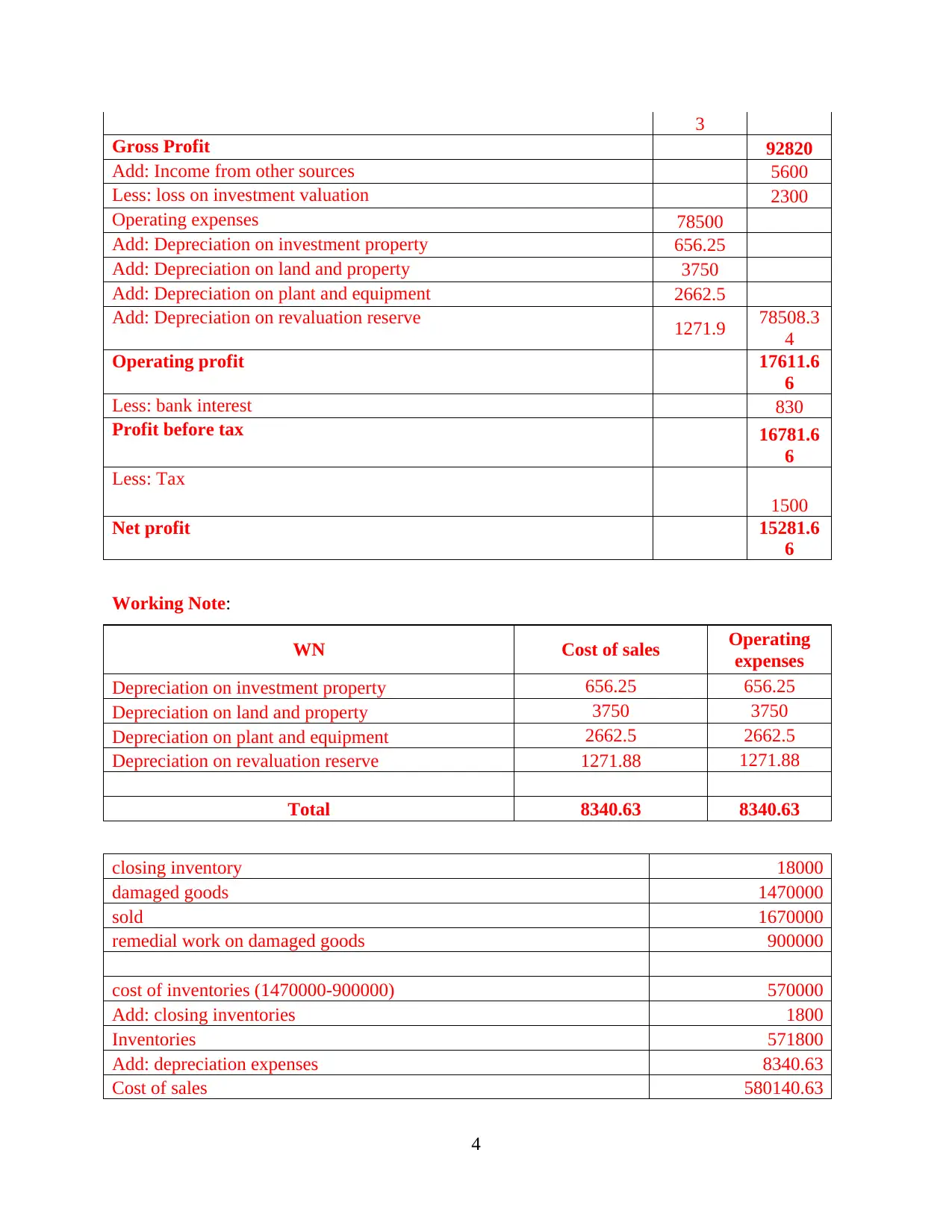
3
Gross Profit 92820
Add: Income from other sources 5600
Less: loss on investment valuation 2300
Operating expenses 78500
Add: Depreciation on investment property 656.25
Add: Depreciation on land and property 3750
Add: Depreciation on plant and equipment 2662.5
Add: Depreciation on revaluation reserve 1271.9 78508.3
4
Operating profit 17611.6
6
Less: bank interest 830
Profit before tax 16781.6
6
Less: Tax
1500
Net profit 15281.6
6
Working Note:
WN Cost of sales Operating
expenses
Depreciation on investment property 656.25 656.25
Depreciation on land and property 3750 3750
Depreciation on plant and equipment 2662.5 2662.5
Depreciation on revaluation reserve 1271.88 1271.88
Total 8340.63 8340.63
closing inventory 18000
damaged goods 1470000
sold 1670000
remedial work on damaged goods 900000
cost of inventories (1470000-900000) 570000
Add: closing inventories 1800
Inventories 571800
Add: depreciation expenses 8340.63
Cost of sales 580140.63
4
Gross Profit 92820
Add: Income from other sources 5600
Less: loss on investment valuation 2300
Operating expenses 78500
Add: Depreciation on investment property 656.25
Add: Depreciation on land and property 3750
Add: Depreciation on plant and equipment 2662.5
Add: Depreciation on revaluation reserve 1271.9 78508.3
4
Operating profit 17611.6
6
Less: bank interest 830
Profit before tax 16781.6
6
Less: Tax
1500
Net profit 15281.6
6
Working Note:
WN Cost of sales Operating
expenses
Depreciation on investment property 656.25 656.25
Depreciation on land and property 3750 3750
Depreciation on plant and equipment 2662.5 2662.5
Depreciation on revaluation reserve 1271.88 1271.88
Total 8340.63 8340.63
closing inventory 18000
damaged goods 1470000
sold 1670000
remedial work on damaged goods 900000
cost of inventories (1470000-900000) 570000
Add: closing inventories 1800
Inventories 571800
Add: depreciation expenses 8340.63
Cost of sales 580140.63
4
⊘ This is a preview!⊘
Do you want full access?
Subscribe today to unlock all pages.

Trusted by 1+ million students worldwide
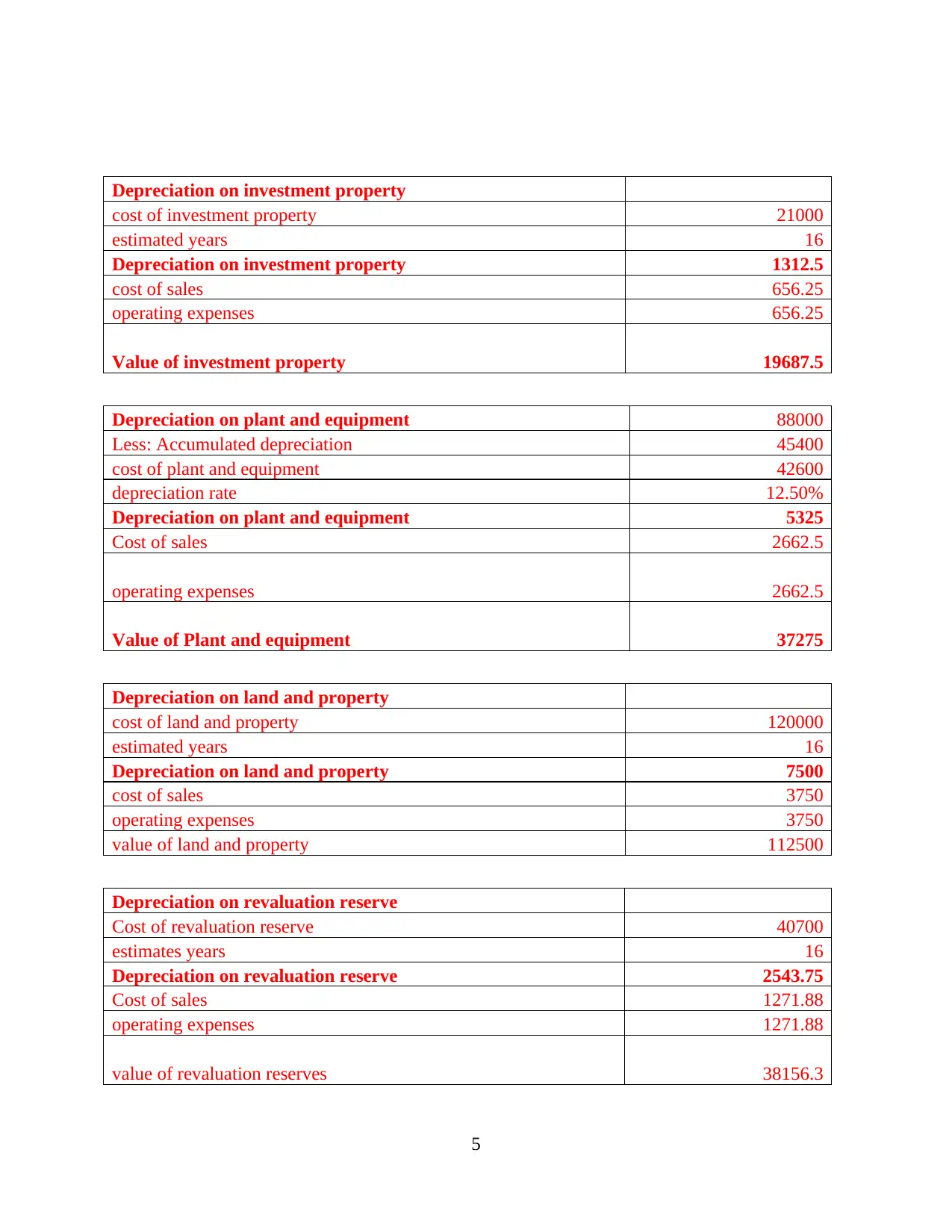
Depreciation on investment property
cost of investment property 21000
estimated years 16
Depreciation on investment property 1312.5
cost of sales 656.25
operating expenses 656.25
Value of investment property 19687.5
Depreciation on plant and equipment 88000
Less: Accumulated depreciation 45400
cost of plant and equipment 42600
depreciation rate 12.50%
Depreciation on plant and equipment 5325
Cost of sales 2662.5
operating expenses 2662.5
Value of Plant and equipment 37275
Depreciation on land and property
cost of land and property 120000
estimated years 16
Depreciation on land and property 7500
cost of sales 3750
operating expenses 3750
value of land and property 112500
Depreciation on revaluation reserve
Cost of revaluation reserve 40700
estimates years 16
Depreciation on revaluation reserve 2543.75
Cost of sales 1271.88
operating expenses 1271.88
value of revaluation reserves 38156.3
5
cost of investment property 21000
estimated years 16
Depreciation on investment property 1312.5
cost of sales 656.25
operating expenses 656.25
Value of investment property 19687.5
Depreciation on plant and equipment 88000
Less: Accumulated depreciation 45400
cost of plant and equipment 42600
depreciation rate 12.50%
Depreciation on plant and equipment 5325
Cost of sales 2662.5
operating expenses 2662.5
Value of Plant and equipment 37275
Depreciation on land and property
cost of land and property 120000
estimated years 16
Depreciation on land and property 7500
cost of sales 3750
operating expenses 3750
value of land and property 112500
Depreciation on revaluation reserve
Cost of revaluation reserve 40700
estimates years 16
Depreciation on revaluation reserve 2543.75
Cost of sales 1271.88
operating expenses 1271.88
value of revaluation reserves 38156.3
5
Paraphrase This Document
Need a fresh take? Get an instant paraphrase of this document with our AI Paraphraser
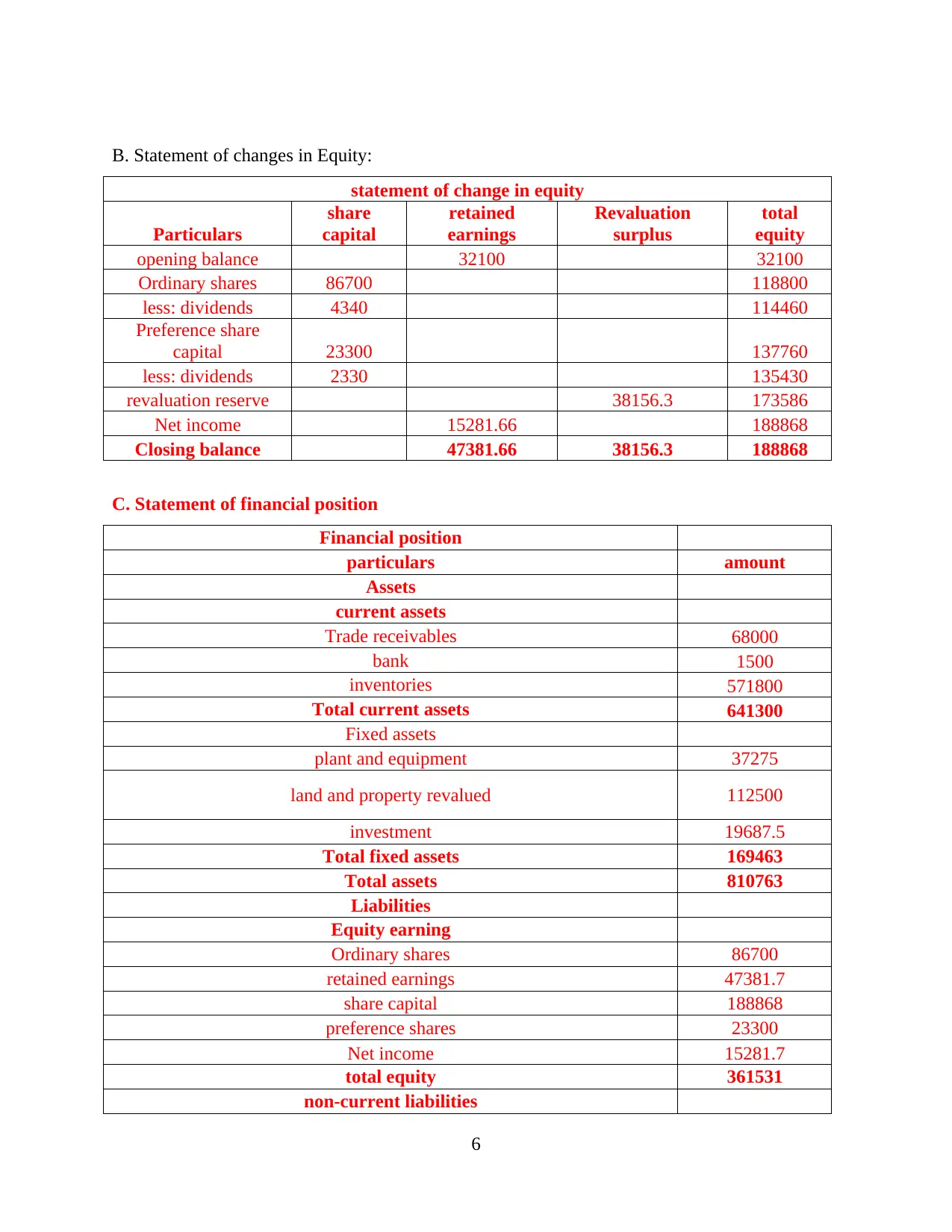
B. Statement of changes in Equity:
statement of change in equity
Particulars
share
capital
retained
earnings
Revaluation
surplus
total
equity
opening balance 32100 32100
Ordinary shares 86700 118800
less: dividends 4340 114460
Preference share
capital 23300 137760
less: dividends 2330 135430
revaluation reserve 38156.3 173586
Net income 15281.66 188868
Closing balance 47381.66 38156.3 188868
C. Statement of financial position
Financial position
particulars amount
Assets
current assets
Trade receivables 68000
bank 1500
inventories 571800
Total current assets 641300
Fixed assets
plant and equipment 37275
land and property revalued 112500
investment 19687.5
Total fixed assets 169463
Total assets 810763
Liabilities
Equity earning
Ordinary shares 86700
retained earnings 47381.7
share capital 188868
preference shares 23300
Net income 15281.7
total equity 361531
non-current liabilities
6
statement of change in equity
Particulars
share
capital
retained
earnings
Revaluation
surplus
total
equity
opening balance 32100 32100
Ordinary shares 86700 118800
less: dividends 4340 114460
Preference share
capital 23300 137760
less: dividends 2330 135430
revaluation reserve 38156.3 173586
Net income 15281.66 188868
Closing balance 47381.66 38156.3 188868
C. Statement of financial position
Financial position
particulars amount
Assets
current assets
Trade receivables 68000
bank 1500
inventories 571800
Total current assets 641300
Fixed assets
plant and equipment 37275
land and property revalued 112500
investment 19687.5
Total fixed assets 169463
Total assets 810763
Liabilities
Equity earning
Ordinary shares 86700
retained earnings 47381.7
share capital 188868
preference shares 23300
Net income 15281.7
total equity 361531
non-current liabilities
6
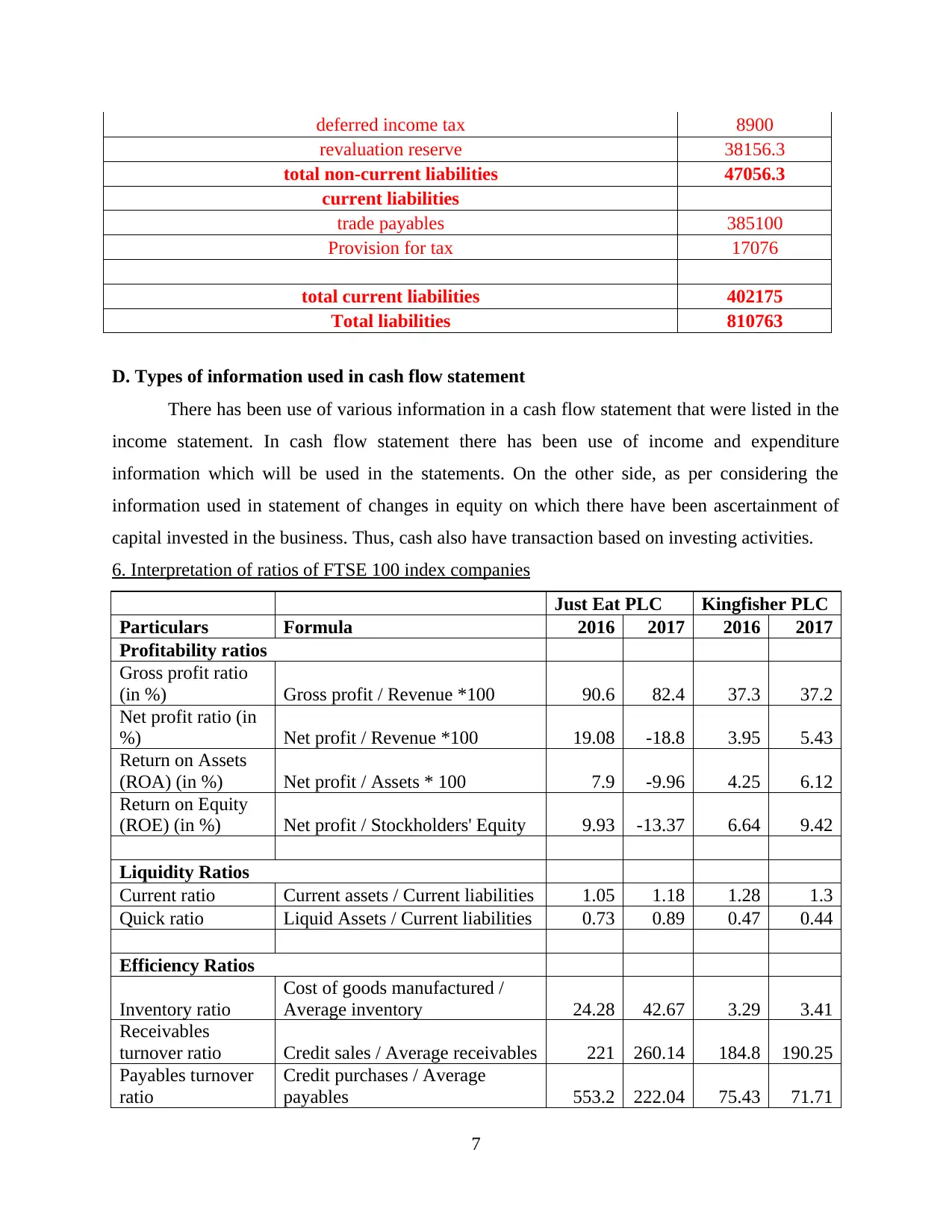
deferred income tax 8900
revaluation reserve 38156.3
total non-current liabilities 47056.3
current liabilities
trade payables 385100
Provision for tax 17076
total current liabilities 402175
Total liabilities 810763
D. Types of information used in cash flow statement
There has been use of various information in a cash flow statement that were listed in the
income statement. In cash flow statement there has been use of income and expenditure
information which will be used in the statements. On the other side, as per considering the
information used in statement of changes in equity on which there have been ascertainment of
capital invested in the business. Thus, cash also have transaction based on investing activities.
6. Interpretation of ratios of FTSE 100 index companies
Just Eat PLC Kingfisher PLC
Particulars Formula 2016 2017 2016 2017
Profitability ratios
Gross profit ratio
(in %) Gross profit / Revenue *100 90.6 82.4 37.3 37.2
Net profit ratio (in
%) Net profit / Revenue *100 19.08 -18.8 3.95 5.43
Return on Assets
(ROA) (in %) Net profit / Assets * 100 7.9 -9.96 4.25 6.12
Return on Equity
(ROE) (in %) Net profit / Stockholders' Equity 9.93 -13.37 6.64 9.42
Liquidity Ratios
Current ratio Current assets / Current liabilities 1.05 1.18 1.28 1.3
Quick ratio Liquid Assets / Current liabilities 0.73 0.89 0.47 0.44
Efficiency Ratios
Inventory ratio
Cost of goods manufactured /
Average inventory 24.28 42.67 3.29 3.41
Receivables
turnover ratio Credit sales / Average receivables 221 260.14 184.8 190.25
Payables turnover
ratio
Credit purchases / Average
payables 553.2 222.04 75.43 71.71
7
revaluation reserve 38156.3
total non-current liabilities 47056.3
current liabilities
trade payables 385100
Provision for tax 17076
total current liabilities 402175
Total liabilities 810763
D. Types of information used in cash flow statement
There has been use of various information in a cash flow statement that were listed in the
income statement. In cash flow statement there has been use of income and expenditure
information which will be used in the statements. On the other side, as per considering the
information used in statement of changes in equity on which there have been ascertainment of
capital invested in the business. Thus, cash also have transaction based on investing activities.
6. Interpretation of ratios of FTSE 100 index companies
Just Eat PLC Kingfisher PLC
Particulars Formula 2016 2017 2016 2017
Profitability ratios
Gross profit ratio
(in %) Gross profit / Revenue *100 90.6 82.4 37.3 37.2
Net profit ratio (in
%) Net profit / Revenue *100 19.08 -18.8 3.95 5.43
Return on Assets
(ROA) (in %) Net profit / Assets * 100 7.9 -9.96 4.25 6.12
Return on Equity
(ROE) (in %) Net profit / Stockholders' Equity 9.93 -13.37 6.64 9.42
Liquidity Ratios
Current ratio Current assets / Current liabilities 1.05 1.18 1.28 1.3
Quick ratio Liquid Assets / Current liabilities 0.73 0.89 0.47 0.44
Efficiency Ratios
Inventory ratio
Cost of goods manufactured /
Average inventory 24.28 42.67 3.29 3.41
Receivables
turnover ratio Credit sales / Average receivables 221 260.14 184.8 190.25
Payables turnover
ratio
Credit purchases / Average
payables 553.2 222.04 75.43 71.71
7
⊘ This is a preview!⊘
Do you want full access?
Subscribe today to unlock all pages.

Trusted by 1+ million students worldwide
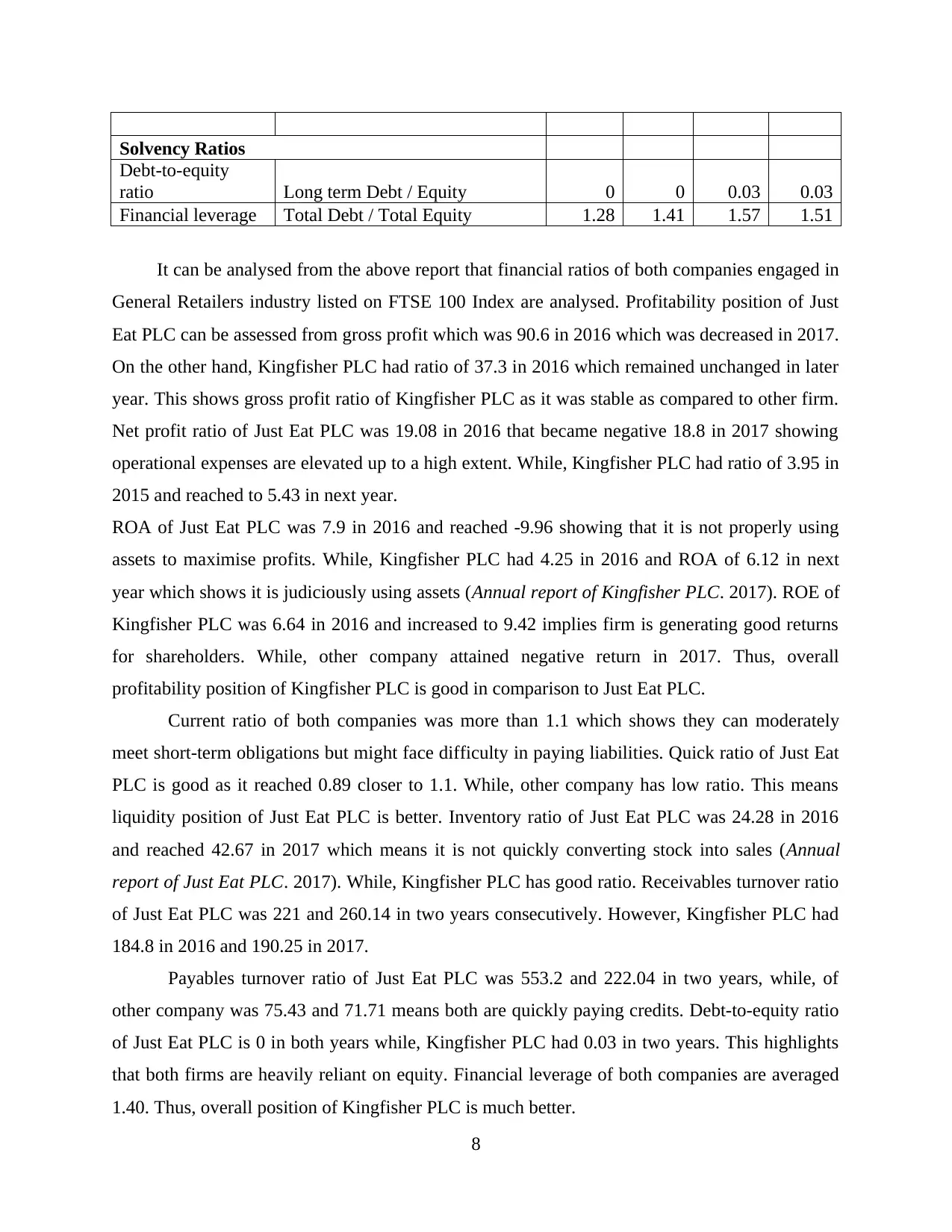
Solvency Ratios
Debt-to-equity
ratio Long term Debt / Equity 0 0 0.03 0.03
Financial leverage Total Debt / Total Equity 1.28 1.41 1.57 1.51
It can be analysed from the above report that financial ratios of both companies engaged in
General Retailers industry listed on FTSE 100 Index are analysed. Profitability position of Just
Eat PLC can be assessed from gross profit which was 90.6 in 2016 which was decreased in 2017.
On the other hand, Kingfisher PLC had ratio of 37.3 in 2016 which remained unchanged in later
year. This shows gross profit ratio of Kingfisher PLC as it was stable as compared to other firm.
Net profit ratio of Just Eat PLC was 19.08 in 2016 that became negative 18.8 in 2017 showing
operational expenses are elevated up to a high extent. While, Kingfisher PLC had ratio of 3.95 in
2015 and reached to 5.43 in next year.
ROA of Just Eat PLC was 7.9 in 2016 and reached -9.96 showing that it is not properly using
assets to maximise profits. While, Kingfisher PLC had 4.25 in 2016 and ROA of 6.12 in next
year which shows it is judiciously using assets (Annual report of Kingfisher PLC. 2017). ROE of
Kingfisher PLC was 6.64 in 2016 and increased to 9.42 implies firm is generating good returns
for shareholders. While, other company attained negative return in 2017. Thus, overall
profitability position of Kingfisher PLC is good in comparison to Just Eat PLC.
Current ratio of both companies was more than 1.1 which shows they can moderately
meet short-term obligations but might face difficulty in paying liabilities. Quick ratio of Just Eat
PLC is good as it reached 0.89 closer to 1.1. While, other company has low ratio. This means
liquidity position of Just Eat PLC is better. Inventory ratio of Just Eat PLC was 24.28 in 2016
and reached 42.67 in 2017 which means it is not quickly converting stock into sales (Annual
report of Just Eat PLC. 2017). While, Kingfisher PLC has good ratio. Receivables turnover ratio
of Just Eat PLC was 221 and 260.14 in two years consecutively. However, Kingfisher PLC had
184.8 in 2016 and 190.25 in 2017.
Payables turnover ratio of Just Eat PLC was 553.2 and 222.04 in two years, while, of
other company was 75.43 and 71.71 means both are quickly paying credits. Debt-to-equity ratio
of Just Eat PLC is 0 in both years while, Kingfisher PLC had 0.03 in two years. This highlights
that both firms are heavily reliant on equity. Financial leverage of both companies are averaged
1.40. Thus, overall position of Kingfisher PLC is much better.
8
Debt-to-equity
ratio Long term Debt / Equity 0 0 0.03 0.03
Financial leverage Total Debt / Total Equity 1.28 1.41 1.57 1.51
It can be analysed from the above report that financial ratios of both companies engaged in
General Retailers industry listed on FTSE 100 Index are analysed. Profitability position of Just
Eat PLC can be assessed from gross profit which was 90.6 in 2016 which was decreased in 2017.
On the other hand, Kingfisher PLC had ratio of 37.3 in 2016 which remained unchanged in later
year. This shows gross profit ratio of Kingfisher PLC as it was stable as compared to other firm.
Net profit ratio of Just Eat PLC was 19.08 in 2016 that became negative 18.8 in 2017 showing
operational expenses are elevated up to a high extent. While, Kingfisher PLC had ratio of 3.95 in
2015 and reached to 5.43 in next year.
ROA of Just Eat PLC was 7.9 in 2016 and reached -9.96 showing that it is not properly using
assets to maximise profits. While, Kingfisher PLC had 4.25 in 2016 and ROA of 6.12 in next
year which shows it is judiciously using assets (Annual report of Kingfisher PLC. 2017). ROE of
Kingfisher PLC was 6.64 in 2016 and increased to 9.42 implies firm is generating good returns
for shareholders. While, other company attained negative return in 2017. Thus, overall
profitability position of Kingfisher PLC is good in comparison to Just Eat PLC.
Current ratio of both companies was more than 1.1 which shows they can moderately
meet short-term obligations but might face difficulty in paying liabilities. Quick ratio of Just Eat
PLC is good as it reached 0.89 closer to 1.1. While, other company has low ratio. This means
liquidity position of Just Eat PLC is better. Inventory ratio of Just Eat PLC was 24.28 in 2016
and reached 42.67 in 2017 which means it is not quickly converting stock into sales (Annual
report of Just Eat PLC. 2017). While, Kingfisher PLC has good ratio. Receivables turnover ratio
of Just Eat PLC was 221 and 260.14 in two years consecutively. However, Kingfisher PLC had
184.8 in 2016 and 190.25 in 2017.
Payables turnover ratio of Just Eat PLC was 553.2 and 222.04 in two years, while, of
other company was 75.43 and 71.71 means both are quickly paying credits. Debt-to-equity ratio
of Just Eat PLC is 0 in both years while, Kingfisher PLC had 0.03 in two years. This highlights
that both firms are heavily reliant on equity. Financial leverage of both companies are averaged
1.40. Thus, overall position of Kingfisher PLC is much better.
8
Paraphrase This Document
Need a fresh take? Get an instant paraphrase of this document with our AI Paraphraser
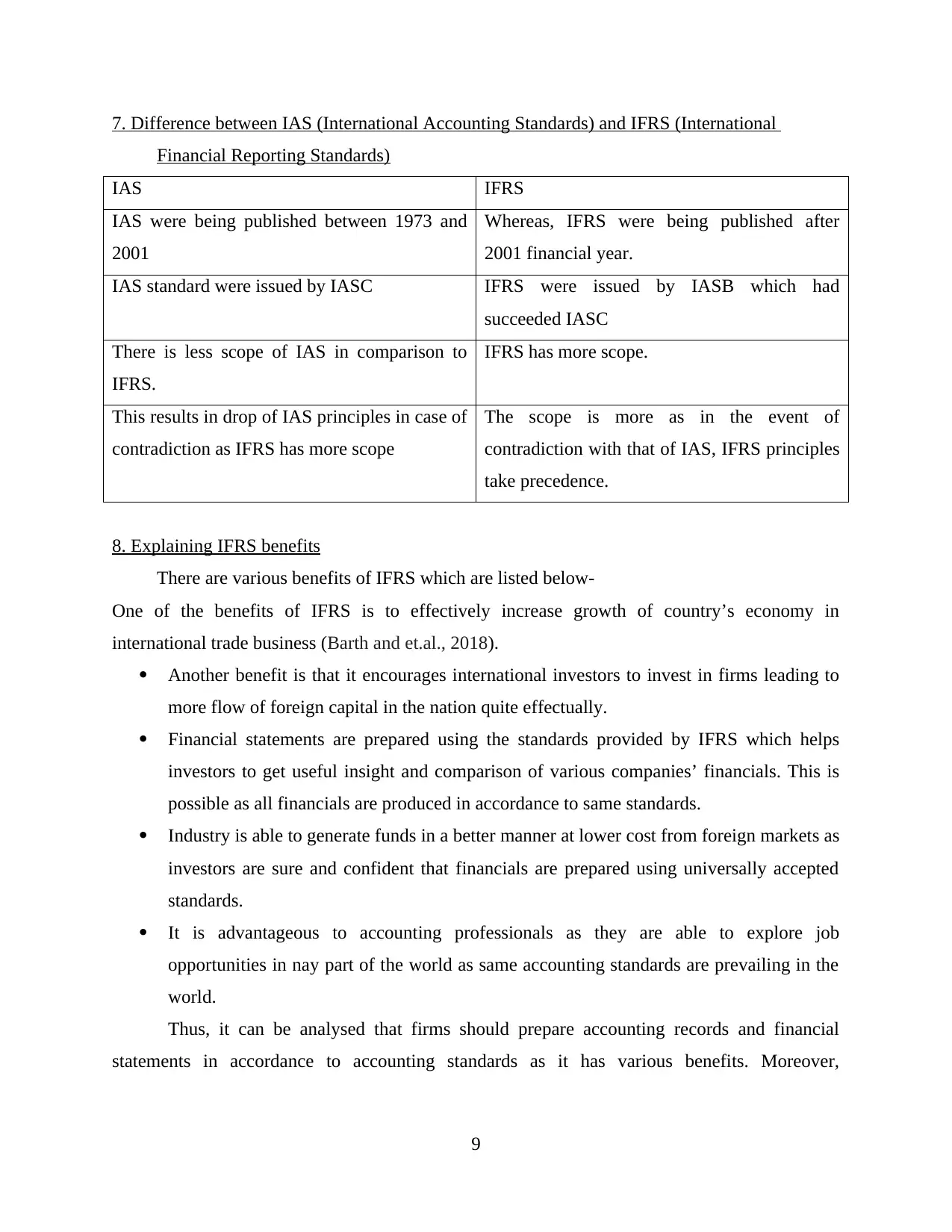
7. Difference between IAS (International Accounting Standards) and IFRS (International
Financial Reporting Standards)
IAS IFRS
IAS were being published between 1973 and
2001
Whereas, IFRS were being published after
2001 financial year.
IAS standard were issued by IASC IFRS were issued by IASB which had
succeeded IASC
There is less scope of IAS in comparison to
IFRS.
IFRS has more scope.
This results in drop of IAS principles in case of
contradiction as IFRS has more scope
The scope is more as in the event of
contradiction with that of IAS, IFRS principles
take precedence.
8. Explaining IFRS benefits
There are various benefits of IFRS which are listed below-
One of the benefits of IFRS is to effectively increase growth of country’s economy in
international trade business (Barth and et.al., 2018).
Another benefit is that it encourages international investors to invest in firms leading to
more flow of foreign capital in the nation quite effectually.
Financial statements are prepared using the standards provided by IFRS which helps
investors to get useful insight and comparison of various companies’ financials. This is
possible as all financials are produced in accordance to same standards.
Industry is able to generate funds in a better manner at lower cost from foreign markets as
investors are sure and confident that financials are prepared using universally accepted
standards.
It is advantageous to accounting professionals as they are able to explore job
opportunities in nay part of the world as same accounting standards are prevailing in the
world.
Thus, it can be analysed that firms should prepare accounting records and financial
statements in accordance to accounting standards as it has various benefits. Moreover,
9
Financial Reporting Standards)
IAS IFRS
IAS were being published between 1973 and
2001
Whereas, IFRS were being published after
2001 financial year.
IAS standard were issued by IASC IFRS were issued by IASB which had
succeeded IASC
There is less scope of IAS in comparison to
IFRS.
IFRS has more scope.
This results in drop of IAS principles in case of
contradiction as IFRS has more scope
The scope is more as in the event of
contradiction with that of IAS, IFRS principles
take precedence.
8. Explaining IFRS benefits
There are various benefits of IFRS which are listed below-
One of the benefits of IFRS is to effectively increase growth of country’s economy in
international trade business (Barth and et.al., 2018).
Another benefit is that it encourages international investors to invest in firms leading to
more flow of foreign capital in the nation quite effectually.
Financial statements are prepared using the standards provided by IFRS which helps
investors to get useful insight and comparison of various companies’ financials. This is
possible as all financials are produced in accordance to same standards.
Industry is able to generate funds in a better manner at lower cost from foreign markets as
investors are sure and confident that financials are prepared using universally accepted
standards.
It is advantageous to accounting professionals as they are able to explore job
opportunities in nay part of the world as same accounting standards are prevailing in the
world.
Thus, it can be analysed that firms should prepare accounting records and financial
statements in accordance to accounting standards as it has various benefits. Moreover,
9
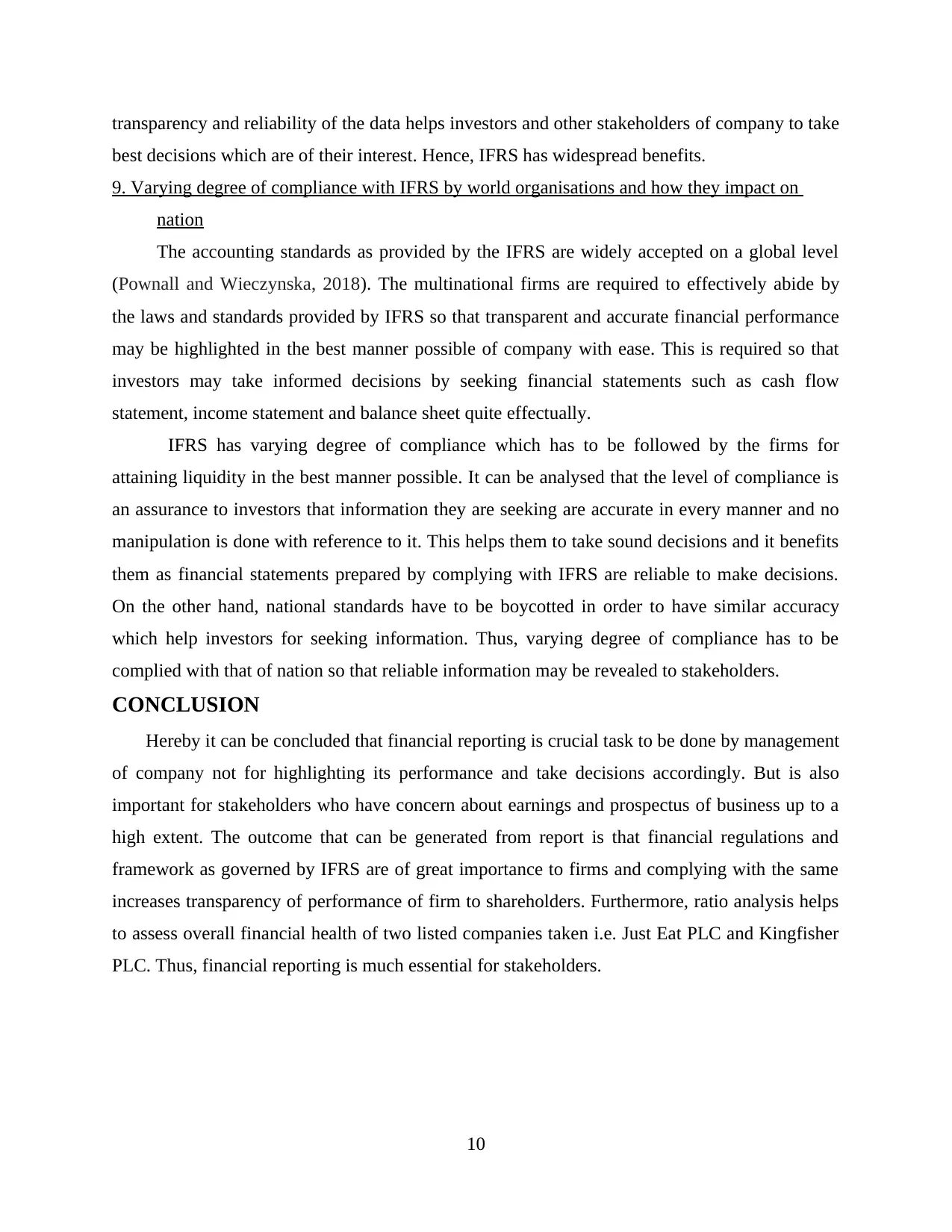
transparency and reliability of the data helps investors and other stakeholders of company to take
best decisions which are of their interest. Hence, IFRS has widespread benefits.
9. Varying degree of compliance with IFRS by world organisations and how they impact on
nation
The accounting standards as provided by the IFRS are widely accepted on a global level
(Pownall and Wieczynska, 2018). The multinational firms are required to effectively abide by
the laws and standards provided by IFRS so that transparent and accurate financial performance
may be highlighted in the best manner possible of company with ease. This is required so that
investors may take informed decisions by seeking financial statements such as cash flow
statement, income statement and balance sheet quite effectually.
IFRS has varying degree of compliance which has to be followed by the firms for
attaining liquidity in the best manner possible. It can be analysed that the level of compliance is
an assurance to investors that information they are seeking are accurate in every manner and no
manipulation is done with reference to it. This helps them to take sound decisions and it benefits
them as financial statements prepared by complying with IFRS are reliable to make decisions.
On the other hand, national standards have to be boycotted in order to have similar accuracy
which help investors for seeking information. Thus, varying degree of compliance has to be
complied with that of nation so that reliable information may be revealed to stakeholders.
CONCLUSION
Hereby it can be concluded that financial reporting is crucial task to be done by management
of company not for highlighting its performance and take decisions accordingly. But is also
important for stakeholders who have concern about earnings and prospectus of business up to a
high extent. The outcome that can be generated from report is that financial regulations and
framework as governed by IFRS are of great importance to firms and complying with the same
increases transparency of performance of firm to shareholders. Furthermore, ratio analysis helps
to assess overall financial health of two listed companies taken i.e. Just Eat PLC and Kingfisher
PLC. Thus, financial reporting is much essential for stakeholders.
10
best decisions which are of their interest. Hence, IFRS has widespread benefits.
9. Varying degree of compliance with IFRS by world organisations and how they impact on
nation
The accounting standards as provided by the IFRS are widely accepted on a global level
(Pownall and Wieczynska, 2018). The multinational firms are required to effectively abide by
the laws and standards provided by IFRS so that transparent and accurate financial performance
may be highlighted in the best manner possible of company with ease. This is required so that
investors may take informed decisions by seeking financial statements such as cash flow
statement, income statement and balance sheet quite effectually.
IFRS has varying degree of compliance which has to be followed by the firms for
attaining liquidity in the best manner possible. It can be analysed that the level of compliance is
an assurance to investors that information they are seeking are accurate in every manner and no
manipulation is done with reference to it. This helps them to take sound decisions and it benefits
them as financial statements prepared by complying with IFRS are reliable to make decisions.
On the other hand, national standards have to be boycotted in order to have similar accuracy
which help investors for seeking information. Thus, varying degree of compliance has to be
complied with that of nation so that reliable information may be revealed to stakeholders.
CONCLUSION
Hereby it can be concluded that financial reporting is crucial task to be done by management
of company not for highlighting its performance and take decisions accordingly. But is also
important for stakeholders who have concern about earnings and prospectus of business up to a
high extent. The outcome that can be generated from report is that financial regulations and
framework as governed by IFRS are of great importance to firms and complying with the same
increases transparency of performance of firm to shareholders. Furthermore, ratio analysis helps
to assess overall financial health of two listed companies taken i.e. Just Eat PLC and Kingfisher
PLC. Thus, financial reporting is much essential for stakeholders.
10
⊘ This is a preview!⊘
Do you want full access?
Subscribe today to unlock all pages.

Trusted by 1+ million students worldwide
1 out of 13
Related Documents
Your All-in-One AI-Powered Toolkit for Academic Success.
+13062052269
info@desklib.com
Available 24*7 on WhatsApp / Email
![[object Object]](/_next/static/media/star-bottom.7253800d.svg)
Unlock your academic potential
Copyright © 2020–2025 A2Z Services. All Rights Reserved. Developed and managed by ZUCOL.





